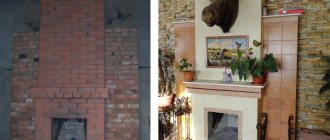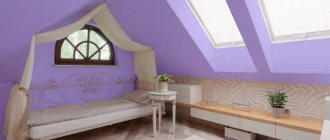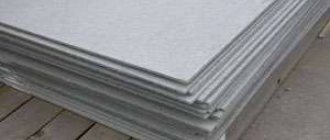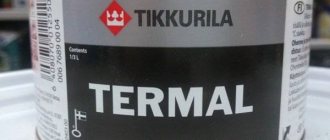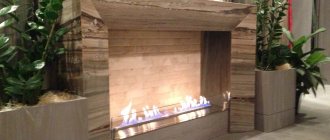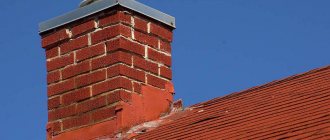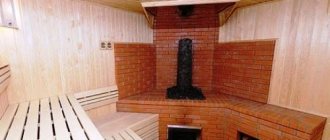Advantages of plastering the stove
Without decoration, the walls of the stove do not look aesthetically pleasing, since building bricks are used for masonry without the use of neat facing bricks. Such heating structures are always finished with finishing materials. Here are a few reasons why the use of plaster is important:
- The fine-grained mortar fills the pores in the masonry mixture. This prevents carbon dioxide from entering the room.
- The leveling mixture can be used as a stand-alone coating or as a base for any heat-resistant facing material.
- Plaster is acceptable for finishing any stove or fireplace. This could be restoration, strengthening or decoration. At the same time, the universal mixture can be considered an economically advantageous choice due to its relatively low cost.
In addition, this material, to one degree or another, has insulating properties, which helps to retain the heat of the furnace walls for a longer time. The solution is easy to work with and dries quickly. You can give the oven surface a smooth, rough or decorative texture.
Decorative plaster on the stove Source www.elitfasad.rf
Advantages and disadvantages
One of the main advantages of heat-resistant plaster is its affordable cost, although due to the reinforced composition it will be a little more expensive than conventional building materials. But it has much more advantages:
- Good adhesion to any substrate;
- Resistance to cracking due to thermal expansion;
- Fire safety;
- Environmentally friendly (if the composition does not contain asbestos fiber).
This material has the only drawback - it is undesirable to use it as a finishing material. And although this is possible in principle, a boring gray color will require at least whitewashing the leveled surface, or better yet, covering it with tiles or decorative stone.
Choosing plaster for finishing the stove
The main requirement for what to plaster a stove with is resistance to regular heating and cooling. At the same time, the shape must be maintained, which means thermal expansion should be minimal. The issue of mechanical stability and wear resistance is also considered. If cladding is planned further, the coating must cope with the additional load.
All solutions are conventionally divided into simple and complex. The determining criterion is the presence of one or more binding components in the composition. This may be cement, clay, lime, gypsum or asbestos.
Cement
M150-M500 grades of cement are used for working with furnaces. A simple mixture is unacceptable, since concrete is characterized by low elasticity, fragility and poor resistance to heat. Additionally, clay pulp is added to the solution.
Clay
This material may vary in terms of fat content. The degree is determined by the sand content. The less it is, the better the adhesion, strength and resistance to temperature changes.
Checking the fat content of clay Source remont-book.com
If you prepare your own plaster mixture from clay, you must exclude stones, debris and vegetation debris. This can be done by soaking for 4-5 days and rubbing the raw materials on a metal mesh with small cells.
Among the advantages of using clay plaster for stoves and fireplaces are environmental friendliness, plasticity and long working time of the solution. It is also noteworthy that it can be applied without using a painting tool, that is, by hand. But it is important to take into account the fact that the minimum layer is 10 mm. If it is not followed, the coating will crack and peel off from the base within a short time.
Gypsum
This material is used to give the solution strength, which is especially important for the formation of stucco. But simple mixtures with its participation are not suitable for working with furnaces, since cracking of the coating occurs. As a rule, additional lime and clay are added to increase strength, elasticity, and reduce drying time. The main mineral typically hardens after 10-15 minutes, so you need to mix the solution in small portions.
Decorating the fireplace with stucco Source masterdel.ru
See also: Catalog of house projects with a fireplace and stove
Asbestos
It is not recommended to use asbestos as the main component, since when heated it releases harmful substances. It is added to the solution as a reinforcing additive before plastering the stove to prevent the finish from cracking over time. Also, this mixture lasts a long time, is resistant to moisture, and fireproof.
Lime
This material is used to impart plasticity to the solution and increase adhesive properties. Lime also has a positive effect on the inertness of the coating to biological activity. That is, the risk of insects is reduced.
Finishing technologies
Method 1. Painting or whitewashing
Whitewashing or painting is the easiest way!
The easiest way to decorate the surface of a Russian stove is to whitewash it. This technology can be called traditional, since kilns have been whitewashed, probably since the very moment of their invention.
For whitewashing you can use the following compositions:
- chalk is cheap, easy to apply, but after drying it sticks to almost any surface. This problem can be dealt with by applying protective compounds that form an impenetrable film, but then a reasonable question arises - why is there chalk in this scheme?
Chalk - cheap and cheerful!
- lime is not much more expensive than chalk, it is also quite easy to apply, but it does not crumble so much upon contact with a whitewashed surface. Both plastered and cleaned brick walls of ovens can be whitewashed with lime.
Lime is considered a more reliable option
Still, whitewashing is an outdated technique, so it’s worth paying attention to the range of paints available in the retail chain.
A Russian stove whitewashed with lime is more like yesterday than tomorrow
As a rule, in any more or less large hardware store you can find a composition intended for application to the surfaces of stoves and fireplaces.
Modern finishing method - ready-made composition
The painting technology is extremely simple:
- Dry the plastered surface or clean the brickwork.
- We dilute the paint by about 30-40% and apply the first, primer layer.
Spread, apply, admire!
- When the paint dries, apply a layer of undiluted composition. We repeat the operation 2-3 times until the desired result is achieved.
- Dry the paint and then heat the oven.
- When the structure has cooled, apply a finishing coat of paint.
The base part of the stove is painted with a heat-resistant compound
Finishing of an iron stove, as well as cast iron products, is also carried out by painting. To apply a composition that not only improves the appearance of the structure, but also protects the metal from corrosion, it is most convenient to use a sprayer - this way the pigment will lay down in an even, thin layer.
When decorating homemade metal stoves, hot painting is practiced - the so-called bluing. This technology is quite effective, but requires special skills, so without experience or at least without the supervision of a specialist who can advise you during the work process, you should not take risks.
Remember, everyone should mind their own business!
Method 2. Facing
When choosing how to decorate a brick stove, many opt for cladding with various tile materials. Of course, ordinary tiles will not work here - they simply will not withstand temperature changes and regular heating, so you will have to look for a suitable material.
Photo of majolica - glazed tiles
For decorative cladding of stoves and fireplaces, you can use a variety of products based on baked clay. I have described the most popular ones in the table below:
| Tile | Peculiarities |
| The most ancient type of ceramics, which is products made from baked compacted clay. The surface of terracotta is not covered with glaze, which is why the tile has a rough texture. Colors are natural, from creamy white to brick red. |
| The production technology is similar to the technique used to make terracotta tiles, but the surface is covered with glaze. Previously, majolica was painted exclusively by hand (and therefore cost), but now the design is applied by machine, which makes production cheaper. |
| Clinker tiles are a more user-friendly alternative to facing heat-resistant bricks. When producing clinker, fireclay and other fire-resistant components are added to the clay mixture. After firing, durable, dense panels with a thickness of 7-8 to 12-15 mm with good heat resistance are obtained. Clinker tiles are most often produced in natural colors, i.e. in shades of yellow, fawn, brown, etc. |
In addition to tiles, porcelain stoneware and some types of natural stone can also be used for cladding stoves. But you should not use artificial stone: its structure does not allow it to withstand strong heat and temperature changes.
Natural stone for a solid finish
Decorative finishing of stoves using cladding is done as follows:
- To begin with, we prepare the foundation using the technology I described above. We apply clay-cement plaster over the metal mesh (do not level or smooth the surface), drying it thoroughly.
Adhesive composition for stove lining
- Prepare a heat-resistant adhesive mixture. The result of our work largely depends on the quality of the glue, so I recommend that beginners not skimp on the material. In principle, you can glue tiles using a clay-cement mortar, but a good glue “forgives” many mistakes, so it is better for an inexperienced craftsman to use it.
Sequence of actions when tiling the stove
- Using a spatula, apply the glue diluted according to the instructions to the underside of the tile. Using the serrated side of the tool, distribute the composition so that the entire surface is covered with even beads of adhesive.
Porcelain stoneware masonry
- We apply the tile to the base and press it, leveling it. Immediately remove drops of adhesive solution that have fallen on it from the front surface of the tile.
- We carry out the laying in rows, from bottom to top. We leave gaps between the tiles and between the rows: in order for the seam width to be constant, we use spacer inserts.
Don't forget to leave space between the tiles
When facing a structure with terracotta tiles, majolica or clinker, leave seams 5–8 mm wide. In this case, it is desirable that the seam be filled with adhesive solution to approximately half the depth.
When facing, monitor the width of the seam
- The optimal cladding sequence is three to four rows per approach. After the area has been worked out, you should pause for about 20-30 minutes (just enough time to mix the next portion of glue). During this time, the tile will just “grab” on the base.
- After finishing the entire surface of the stove, we leave it for the glue to polymerize. The polymerization period depends on the brand of the composition used, but it is still not worth starting the following operations earlier than 4–6 days .
The finished surface must dry completely
The only exception is surface cleaning. As a rule, 10-12 hours after finishing the job (i.e. the next morning), I carefully clean the joints between the tiles, and then rinse the tiles to remove any remaining grout and other contaminants.
My story about how to tile a stove would be incomplete without mentioning the final stage - grouting. At this stage, all seams between the cladding elements are filled with a special grout mixture, which will protect the adhesive layer from moisture, hide the ends of the tiles and give the structure a complete appearance.
The seams are rubbed with a special compound
Approximately 3 hours after finishing the grouting, the stove is washed again with a damp soft cloth. Then you need to wait about a day and heat the oven for effective drying. You should start regularly using the lined structure no earlier than two weeks after completion of the work.
For effective drying, the oven should be heated
Method 3. Tiles
A brick oven can also be finished with special products - tiles. A tile is a heat-resistant ceramic product of a special shape, which is used exclusively for finishing stoves and fireplaces, providing them with good heat transfer, long-term temperature retention and an attractive appearance.
Different parts for different elements
The technology for installing tiles with your own hands is quite complex, so it is best to master it under the guidance of an experienced stove maker. It is for this reason that here I will give only a general outline of the work:
- First, we select tiles for cladding the structure. Despite the fact that such products cost a lot, we take them with a reserve - at least one piece of each type.
- We carefully adjust all the tiles to the same size, cleaning the edges with a rasp or an angle grinder.
Tile pump
- Before installation, we lay out the products on the floor in accordance with the future location and “shuffle” them so that the difference in shades of adjacent parts is minimal and the color transitions are as smooth as possible.
Before installation, the pattern of tiles should be laid out on the floor to match
- We wet the product, after which we fill its rear cavities - the rumps - halfway with clay mixed with filler (pebbles, gravel, brick fragments, etc.).
- We insert crutches from a rod 4-5 mm thick into the holes of the tiller, tying a piece of soft wire twisted in half to the middle of each crutch. A clay-based masonry mortar is laid on top of the crutch.
Installation diagram: 1. tile, 2. crutch, 3. binding wire, 4. bracket
- When facing, tiles are laid on the front surface of the stove or fireplace in rows, while soft wire is embedded in the seams between the bricks of the wall. Adjacent parts in rows and rows are fastened to each other with metal staples that hook onto the edges of the tillers.
Craftsmen usually fold the cladding first dry, without mortar. If all the details match, then the structure is disassembled and the tiles are reinstalled, but with clay mortar in the rums.
Proportions in a self-prepared solution
To plaster stoves, you can use a simple mixture of fatty clay and sand. The classic version of the composition involves 2 parts of filler to one of binder. Additionally, you can add 1/10 of reinforcing asbestos in a fluffy state.
In the case of cement, the proportional composition looks like this: 4 parts binder, 9 sand and a third of water for the additive. With the use of asbestos, sand is halved, and the reinforcing filler occupies 10% of the total mass of the solution (no other additives except water are present).
Preparing the mixture manually Source fasad-exp.ru
Less commonly used is liquid glass or chalk. As a rule, they are relevant for facing work. Then mix dry cement, clay and chalk 1 part each, sand - 3. Then add pulp to the desired consistency and 1 part liquid glass.
Lime is added to a solution of clay and sand with asbestos reinforcement. Proportionally, it looks like this: one part each of binders, two parts each of sand and water, up to ⅕ asbestos fiber. The question of how to plaster the stove so as not to crack is also approached by using alternative materials: crushed straw or fiberglass, hemp, chaff, slag wool.
Self-preparation of the solution always begins with preliminary mixing of the dry ingredients. This way the finished mixture is as homogeneous as possible. To ensure uniform drying, reduce the risk of cracking of the coating and increase working time, add about 200 grams of table salt per bucket of the mixture.
If the stove is designed to use coal or peat briquettes, then fireclay powder is additionally added to make the plaster resistant to high heat.
Fireclay powder Source wasteinfo.ru
See also: Catalog of companies that specialize in finishing materials and installation of stoves
Ready mixes
Plaster can withstand high temperatures for a long time, does not crack or crumble.
The building materials market is filled with various types of fire-resistant products that allow you to plaster stoves yourself. The most popular, well-deservedly recognized, are the heat-resistant compositions “Fireproof”, “Terracotta”, “Pechnik”.
“Fireproof” mixture, available in three modifications:
- smooth plaster;
- simulated mixture;
- composition for tiled surfaces.
When using a modeled variety, it is possible to obtain a textured surface onto which any pattern can be easily applied. The smooth composition is ideal for painting most stoves.
“Terracotta” is another dry mixture, which includes clay and fine fireclay sand with fireproof additives. The solution is intended for treating surfaces made of ceramic and fireclay bricks and can withstand heating temperatures up to 200 ºC.
The composition called “Kilnmaker” includes lime and sand, as well as gypsum, cement, asbestos and clay.
Technology for plastering a stove
To carry out work on plastering a stove, a set of tools for a mason and a painter is required. You will need a hammer and chisel to work with the base. For the solution, use a container for mixing, spatulas, trowels, graters with smoothers. For alignment, a rule and a level are used.
Additionally, a construction knife, brushes with a roller, and a brush with metal bristles may be useful. The list of consumables looks like this: mixture, water, soil, beacon and corner-forming profile, reinforcing fiber or plaster mesh, gloves, whisk attachment for a drill or hammer drill for preparing the solution. It is also necessary to provide protection for adjacent walls and floors from contamination. For this you will need film and masking tape.
Preparatory work
In the case of a new stove, it is permissible to begin finishing work only after several thorough heatings over a period of 2-3 months. Then shrinkage of the structure, which leads to cracking of the plaster coating, will be eliminated. For older units this requirement is not relevant.
New stove for finishing Source yandex.net
Next, before plastering the stove, you need to carry out preparatory work. The working base is considered to be a clean, grease-free and flat surface. Protruding excess masonry mixture or previous decorative finishing must be removed. Damaged bricks are restored or replaced completely. The depth of the seams must be at least 10 mm. Notches are applied to a durable concrete surface.
Why plaster the stove?
The materials of the Russian stove include:
- clay;
- fireproof (fireclay) brick;
- iron (doors, grates, grates).
Each has its own heating temperature, expansion, and thermal conductivity.
Yes, it is indeed possible to leave the stove unfinished, but after a short time it will lose its neat appearance along the colored seams. If the masonry was done in haste, cracks will begin to appear.
Plastering is performed to strengthen the structure, protect it from drying out, and give it a beautiful appearance.
In addition, the procedure is relevant in the following cases:
- The oven is not laid out neatly. The mixture will help level the corners and sides.
- The old coating began to crack and fall off.
- To increase the strength of the walls, their thickness will increase.
- Heat capacity improvements. The bathhouse or house will remain warm longer.
- The seams were filled with a natural-based mixture, which is why insects settled there.
- The interior design of the room has been changed, so the furniture needs to be decorated in the appropriate style.
- Increases the level of fire safety. It prevents carbon monoxide and smoke from entering the house through cracks in the brickwork.
Using heat-resistant plaster is an excellent way to restore antique stoves, fireplace boxes, followed by laying ceramic tiles, marble and other decor on top.
Briefly about the main thing
The problem of how to plaster a stove to prevent it from cracking can be solved in different ways, using various compositions based on cement, clay, gypsum, asbestos or lime.
The main requirements for leveling materials: elasticity, heat resistance, safety, mechanical strength and low thermal expansion.
The plastering itself is carried out in two ways: a reinforcing mesh made of steel or fiberglass is attached to the walls, or environmentally friendly fibers are added to the solution.
The consistency of the prepared mass depends on the purpose: roughing and grouting - liquid, leveling - like cottage cheese, for installing profiles - thick. At the same time, at each stage of work it is important to comply with the permissible standards regarding the layer. Enlargement causes improper drying, flaking and cracking.
Ratings 0
Properties of thermal plaster
Since finishes for fireplaces and stoves must withstand high thermal loads, all components of the solution must also meet this requirement. Dry heat-resistant mixtures usually include:
- Special aluminous cement;
- Red clay - its thermal expansion corresponds to the indicators of oven bricks;
- Fine aggregate - sand;
- Various fire-resistant fillers - it is better that it is not asbestos, but reinforcing fiberglass.
Such compositions not only do not crack when heated, but also have high adhesion to both brickwork and smooth metal elements. However, the service life of thermal plaster with proper application reaches 50 years. And all thanks to its “tenacity” in the liquid state and increased mechanical strength when solidified.
Many people confuse heat-resistant plaster with warm plaster. Although these are two different materials, each of which has its own scope of application. “Warm” compositions are intended for thin-layer insulation (usually gas or foam concrete masonry). So the prefix “thermo-” in the name of the purchased mixture does not indicate its heat resistance. Therefore, look for packaging on sale that says “for fireplaces and stoves.”
Tools for applying plaster
In order to apply the plaster mixture efficiently, prepare all the necessary tools in advance, and during the work process use those that are more convenient to use. They also buy a primer that will enhance adhesion to the mortar and strengthen the masonry, metal corners, tile adhesive, beacons, and some gypsum plaster.
Here is a list of accessories that may be useful to the master:
- trowel, trowel - for applying and distributing the mortar over the surface of the oven;
- spatulas of different sizes - for applying, leveling, smoothing the composition, especially in corners and other hard-to-reach places;
- construction grater, trowel or trowel - for leveling and rubbing the surface;
- brushes and rollers - for painting dried plaster;
- chisel - for making notches on the surface before plastering, if it is too smooth and does not adhere well to the mortar, and reinforcement has not been carried out;
- hammer - for quickly beating off old mortar;
- metal scissors - for cutting reinforcing fabric;
- level and rule (plumb) - for proper leveling of the coating;
- a construction mixer and a suitable container for mixing plaster;
- hard metal brush - for removing old plaster and cleaning joints.
How to plaster a stove: instructions
Before starting work, carefully prepare the base, because the quality and service life of the plaster layer will depend on this. The walls of the stove or fireplace are freed from the old coating - knock it down with a chisel and hammer. The seams are well cleaned with a brush to remove pieces of plaster and sweep away dust. If the masonry is fresh, remove any adhering and escaped drops of mortar, which can lead to detachment of the new plaster.
The old paint is completely removed. Irregularities and cracks in the bricks are covered up, masonry joints, on the contrary, are deepened by 5-10 mm. If the base is too smooth, small notches are made on it. The walls of the stove or fireplace are primed 2-3 times. The seams are especially well coated with primer.
Reinforcement
If the oven walls are uneven, you will have to apply several layers of plaster. In this case, the frame must be reinforced, otherwise the solution may peel off and crack. Purchase a mesh made of metal or fiberglass with medium-sized cells (1.5-2 cm). The metal material is secured using nails with wide heads, driving them directly between the bricks.
Reinforcing mesh for oven
Fiberglass is attached to a mortar or heat-resistant tile adhesive. To ensure perfect alignment, steel or aluminum corners with perforations are glued to the corners of the stove. In case of sharp unevenness of the walls, plaster is carried out along beacons, which are placed on top of the reinforcing mesh on small piles of gypsum mixture. Beacons are installed according to the level, having previously determined the point of greatest deviation of the plane.
Spray
To properly level the walls, it is necessary that the plaster layer be at least 8-10 mm - this is the only way to get rid of significant distortions. After the mesh is fixed to the surface and the beacons are placed, the oven is heated to a warm state.
Then spray the walls of the oven with water using a wide brush and make a spray. This is the first layer of plaster, up to 4-5 mm thick, which is literally thrown onto the wall. The spray solution has the consistency of medium thick sour cream. After filling the entire area, the plaster is leveled without much effort, but paying attention to the high-quality filling of masonry joints. Allow the composition to dry thoroughly.
Leveling and covering
After the first layer has dried, further work begins. Apply the solution with a spatula or trowel between the beacons, starting from the bottom of each wall, and immediately level it using a small rule. After treating one area, proceed to the next until the entire surface is covered with the solution. Allow the leveling layer to dry, then proceed to covering.
The covering layer is only 1.5-2 mm thick, so the solution for it is made more liquid. It is needed to perfectly level the surface before painting. If you plan to glue tiles, covering is not necessary. As this stage of work is completed, the beacons are removed and the holes are sealed with plaster mixture. The corners are carefully treated with an angle spatula, rounded for your own safety.
Grout
While the surface has not yet completely dried, they begin grouting work. Grinding is carried out with a construction float or matting, not forgetting to regularly moisten the device with water. Move the tool in a circular motion, increasing the pressure in the depressions and decreasing it in the pits. To reduce the risk of cracking of the layer, experienced craftsmen, after finishing plastering work, cover the oven with damp burlap. As a result, it dries more evenly, which improves the quality of the result.
General characteristics of heat-resistant adhesives for ovens
The main factor that determines the name of these materials is operation in high temperature conditions, sometimes in direct contact with fire. When used at high temperatures, heat-resistant adhesive must not only resist destruction, but also maintain its functionality.
General requirements for adhesives intended for furnace construction:
- sufficient resistance to high temperatures for a specific purpose;
- safety – absence of harmful emissions into the air;
- sufficient adhesion with high elasticity of the hardened mixture - to effectively neutralize temperature deformations of the furnace materials;
- ease of installation - optimal consistency, durability and curing time.
Repair of stove plaster
If cracks do appear on the stove coating, this means a violation of the plastering technology or improper operation of the structure (overheating, loosening of doors, etc.). In difficult cases, you will have to reposition the stove, but most often, “cosmetic” repairs help. The work is carried out in the following sequence:
- Completely remove old plaster and whitewash from the surface of the damaged area, remove soot, otherwise the latter will appear from under the layer of mortar in the form of rusty spots.
- Cracked bricks are restored with a special repair mixture or the cracks are filled with heat-resistant mastic. If repairs are impossible, the bricks are replaced with new ones, but plastering begins no earlier than after 7 days.
- Apply the primer with a brush and let it dry.
- Prepare the plaster composition and apply it to the area moistened with water by throwing it on. After leveling the solution, rub it with a construction trowel.
- Loose doors are reinforced with wire, and a clay composition is also applied around the fastening area. Let the stove dry.
If the plaster is made correctly, finishing the stove or repairing it can be done with your own hands. The costs of such work will be small, and the savings on wages for invited craftsmen will be significant.
Interesting options for finishing fireplaces (photo)
All the methods described above can be combined to create finishes in different styles. Sometimes it turns out very beautiful. We post some already implemented ideas below.
Very interesting fireplace design
This option will fit into modern styles
Decorating a fireplace with mosaics is especially good on round shapes, where it is very problematic to use other materials.
Combinations of different types of artificial stone with wood fragments
Flagstone finishing of the fireplace portal and exhaust pipe
Combination of plaster and tiles
There are two options to achieve this effect - paint the existing brick fireplace or veneer it with clinker tiles
This is polished porcelain stoneware
This is unpolished porcelain tile, small format. As you can see, it fits well into round shapes. Horizontal surfaces and columns are also porcelain tiles of a similar texture, but in the form of slabs
Designer version of the cap and trim
Cladding a fireplace with stone can also be done outdoors
Terracotta in combination with a wooden shelf that follows the tile relief
Smooth clinker tiles - strictly and functional
This is a Czech stove tile. Mounted on special racks
Majolica looks very decorative
Non-standard design option
Combination of plaster and tiles
Tile inserts - beauty
The procedure for plastering a fireplace
On the surface with the installed reinforcing mesh we apply the first layer of mortar, the thickness of which should be 3-5 mm. and no more. Applying a base layer of plaster does not provide for perfect leveling of the surface.
At this stage, it is necessary to apply special pads to the corners. They must be made of steel. Since the working furnace has a high temperature, corner pads made of other materials simply will not withstand it and will begin to melt. As a result, deformation of the entire structure will occur. After applying this layer of the mixture, it must be dried for 2-4 hours.
At the second stage of the procedure, we apply the composition to completely level the plane. At the same time, you need to try to make the layer not very thick. Otherwise, the structure will take a long time to dry and this may have a bad effect on its finish. At the second stage, we especially carefully seal the corners, trying to carefully round them.
Now we leave the fireplace for some time until the plaster solution has completely dried. If cracks appear during drying, there is no need to be alarmed. This is easy to fix: use a knife to open the cracks, spray them with water, and then rub them with the same plaster mixture. Now you can apply decorative plaster with any texture that you chose in the store.

